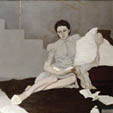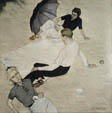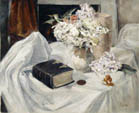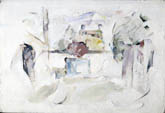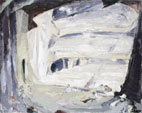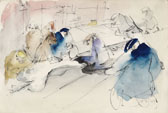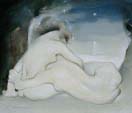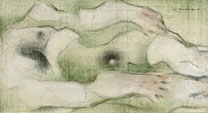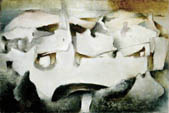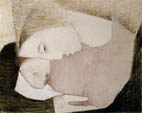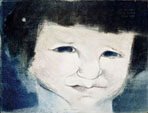Louis le Brocquy was born in Dublin
in 1916. He studied chemistry at Kevin Street Technical School and Trinity
College Dublin. During this period he gains an amateur interest in art,
prompted in particular by music. Produces his first sculpture Evolution (1934; plasticine, plaster cast), alongside the experimental paintings Sunlight in a Wood (a.k.a. Summer Haze, 1935), and L'Après-Midi
d'un Faune (1937), all light-heartedly entered into the Royal Hibernian
Academy exhibitions of 1937-38. Reporting in May 1937, the Dublin Evening
Mail writes: 'One rarely hears of a young artist breaking through the
portals of the Royal Hibernian Academy without having had a lesson in art
... Both his exhibits attracted attention on the opening day ... He is
not, as I had expected, exceptionally keen on art, but is more interested
in his chemistry work. The fact is surprising that these, the only two works
of art which he has ever completed, were accepted and hung in the Academy,
for he has not hitherto taken it devotedly'. In the summer of 1938, however,
le Brocquy will envisage for the first time becoming a painter, having
previously regarded the matter as nothing more or less than a diversion.
Unaccountably drawn to reproductions of old master paintings with which
he had long been familiar, the young chemist immerses himself in the works
of Titian (1485-1576), Velázquez (1599-1660), Goya (1746-1828) and
Manet (1832-1883), later evoking his particular wonder of Rembrandt's A Woman bathing in a Stream (1654; National Gallery, London), in which
'the handling of white lead impasto could miraculously become the
texture of her coarse white dress.' Further in time the artist will record
the following impression: 'Perhaps of all painters, Rembrandt has given
me the deepest insight. Just now, looking long at an overwhelming self-portrait,
I had a disquieting experience. It was not that the hand which held the
brushes in the painting became, so to speak, my hand. It was that I identified
with the paint on the canvas so that my hand understood that painted
hand, felt those painted brushes. For a moment I left the actual
world. For an instant I entered through the looking-glass of this painted
reality, as though into an other room.' ... Realising that painting is an essential
process that concerns him, his laboratory work takes on new experiments
with oils, pigments and wax-resins. Makes frequent visits to Dublin's Municipal
and National Galleries, where the 'deep humanity' of Goya's A Lady in
a Black Mantilla (c.1805; NGI) impresses him, as will El Greco's St.
Francis Receiving the Stigmata (1590-95; NGI), perceived 'within a
white ectoplasmic cloud in which spirit has become paint, paint
spirit.' This metamorphic power of art will remain an enduring source of
wonder throughout the artist's life: 'Since painting first interested me,
I have been drawn to a constant tradition which I think of as central to
this old European art. This implies a peculiar use of oil paint; not to
symbolise, not to describe the object, nor to realise an abstract image
but rather to allow the paint, while insisting upon its own palpable nature,
to reconstitute (if it will) the object of one's experience. In certain
works of old masters, the paint (with its qualities of colour, tone and
texture) has been transformed into the experienced object. Obversely
the image of the object has become paint. This dichotomy, this tension
pulls taut the nerves of insight. Reality is stripped down to a deeper
layer and the ordinary is seen to be marvellous.' ... |

